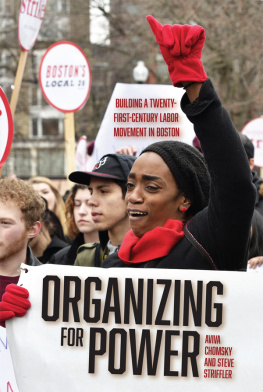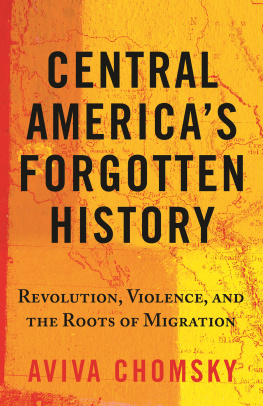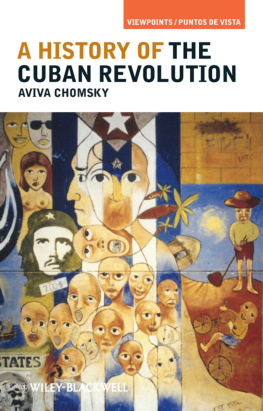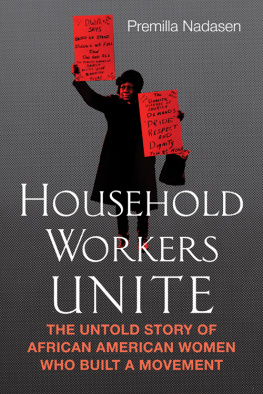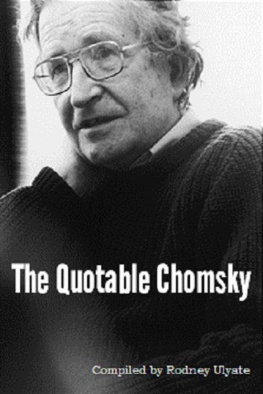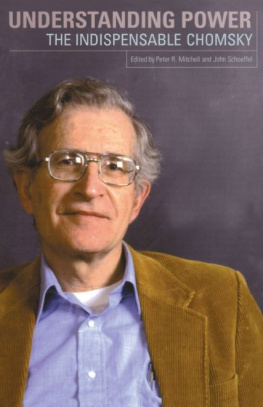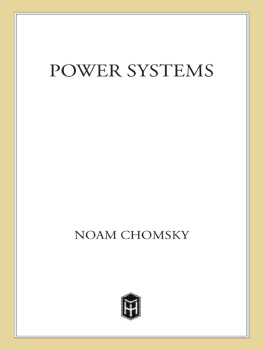PRAISE FOR ORGANIZING FOR POWER
What an excellent look at the significance of class struggle and progressive social movements in the Boston metropolitan area! This is a book that goes beyond examining the institution of unions, but instead focuses on the multifarious efforts to refound a genuine labor movement. Though this book focuses on the Greater Boston area, the examples explored and the lessons learned have a value throughout the country. That the book focuses so clearly on one geographic site of struggle helps it to avoid a level of generality that frequently undermines other analyses.
BILL FLETCHER JR., author of Solidarity Divide d and Theyre Bankrupting Us! and Twenty Other Myths about Unions
These fresh, wide-ranging perspectives on recent labor struggles in the greater Boston area shed light on a surprisingly understudied region of the United States. Taken together, they offer a sobering, yet hopeful portrait of organizing efforts among increasingly precarious working peopleincluding immigrants, women, and people of colorto challenge and transform the neoliberal order.
RUTH MILKMAN, author of Immigrant Labor and the New Precariat
As America has ineluctably transformed into a postindustrial economy, so has the character and nature of its working class. Organizing For Power: Building a Twenty-First Century Labor Movement in Boston is a comprehensive guide to understanding the formative changes in the American class structure and how organized labor can regain relevance to a chaotic spectrum of contemporary workers. Drawing on the shifting landscape of Boston, Chomsky and Strifflers book is essential reading for grasping the opportunities and challenges of trade unions in the United States today.
IMMANUEL NESS, author of Organizing Insurgency:
Workers Movements in the Global South
Organizing for Power offers an uncommonly comprehensive yet granular view of a single city labor movements attempt to cope with structural and demographic change in the early twenty-first century. Striffler and Chomsky have convened an impressive array of postindustrial Bostons labor brain trustincluding academic activists, union leaders and alt-labor strategiststo sketch a path forward on both the organizational and political fronts.
LEON FINK, author of The Long Gilded Age:
American Capitalism and the Lessons of a New World Order
With political polarization and legislative paralysis forestalling progressive innovations at the federal level, unionists and community activists have rightly looked to cities like Seattle, Chicago, Los Angeles, and Boston to build power and construct social policies designed to give workersof all ethnicities, sexual orientations, and legal statusesa voice in twenty-first-century America. In this splendid collection, Aviva Chomsky and Steve Striffler have put in dialogue a wide-ranging set of activists and academics who offer important and insightful accounts of how the Hub City has become a terrain of struggle where the working-class has won important battles, even in an era bookended by Ronald Reagan and Donald Trump. Their stories bare careful readingand emulation!
NELSON LICHTENSTEIN, editor of Capitalism Contested:
The New Deal and Its Legacies

2021 Aviva Chomsky and Steve Striffler
Published in 2021 by
Haymarket Books
P.O. Box 180165
Chicago, IL 60618
773-583-7884
www.haymarketbooks.org
ISBN: 978-1-64259-645-8
Distributed to the trade in the US through Consortium Book Sales and Distribution (www.cbsd.com) and internationally through Ingram Publisher Services International (www.ingramcontent.com).
This book was published with the generous support of Lannan Foundation and Wallace Action Fund.
Special discounts are available for bulk purchases by organizations and institutions. Please email for more information.
Cover design by Rachel Cohen.
Library of Congress Cataloging-in-Publication data is available.
INTRODUCTION
Race, Immigration, and Labor in Boston
Aviva Chomsky and Steve Striffler
Bostons economy is booming, but many Boston residents continue to struggle to make ends meet. The unemployment rate has fallen to pre-recession levels, but the median income has remained unchanged for a generation. A quarter of full-time, full-year workers, and just under half of all labor force participants, earn less than $35,000.
I n July of 2017, twelve hundred nurses at the Tufts Medical Center carried out a one-day strikethe largest nurses strike in Massachusetts history, and the first one in Boston in more than thirty years. By the end of the year, the union signed a compromise contract that won enhanced staffing to improve conditions for nurses who had been overloaded with up to five patients at a time, along with raises and some management concessions to sweeten the unwanted transition from a defined-benefit pension to a defined-contribution retirement plana 401(k). In part because the union had framed the action in terms of patient safety and quality health care, the strike quickly got the support of local labor unions, including apparently unlikely allies like the Building & Construction Trades Council and the Teamsters. Boston mayor Marty Walsh, a former union leader himself, and other community leaders also backed the strikers. The strike captured the attention of the news media, which provided the nurses with generally sympathetic coverage.
Was the nurses strike a sign of increased or resurgent militancy, solidarity, and working-class power? Or is it to be understood as an inspirational, but ultimately isolated, expression of worker discontent that would do little to reverse the decades-long decline of union density and working-class power in the city? Or a mix of both? Only time will tell, though in the intervening period since the summer of 2017, the United States has experienced a remarkable wave of strikes, with New England playing its part. The February 2018 West Virginia teachers strike started it, quickly followed by statewide walkouts in Oklahoma and Arizona as well as teacher revolts throughout the country. By the fall, close to eight thousand Marriott workers were striking in eight cities, including Boston. And some thirty thousand Stop and Shop workers went out on strike throughout New England supermarkets in April 2019, only to be followed by fifty thousand GM workers nationwide that fall.
In all of these cases high levels of community and political support for the workers contributed to broad public approval of unionsdriven in part by increased concerns about runaway inequality. All of this suggests that we are perhaps at a pivotal moment, with the labor movement poised between decades-long decline and potential revival. To be sure, labor unions are decimated and powerful interests continue the political-economic assault against working people. It is far too early to suggest that the strike wave has altered the balance of power in any significant way. Yet, as recent revolts suggest, more and more people are concluding that not only is the system rigged, but that a labor movement rooted in unions and community organizations may provide one of the few ways of blocking or even reversing this decades-long attack on working people.
In this respect, the nurses strike is instructive of some of the obstacles labor faces, which of course are not unique to Boston. This was not a case where management quickly caved when confronted with a powerful union backed by community support. Prior to the one-day strike, the nurses had negotiated for well over a year in more than thirty long and bitter meetings. Their demands around pay, benefits, and working conditions were modest, and focused more on forcing the hospital to meet regional standards than achieving radical change. The nurses backs were up against the wall, and achieving the kind of unity and courage needed to pull off a strike took years of hard workbut by no means assured success. Tufts immediate response was to lock out the nurses and hire out-of-town scabs, threatening patient safety.overwhelming support and attention from labor, community groups, and the media.



